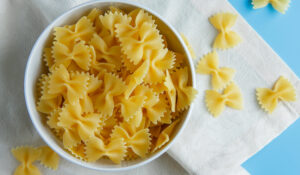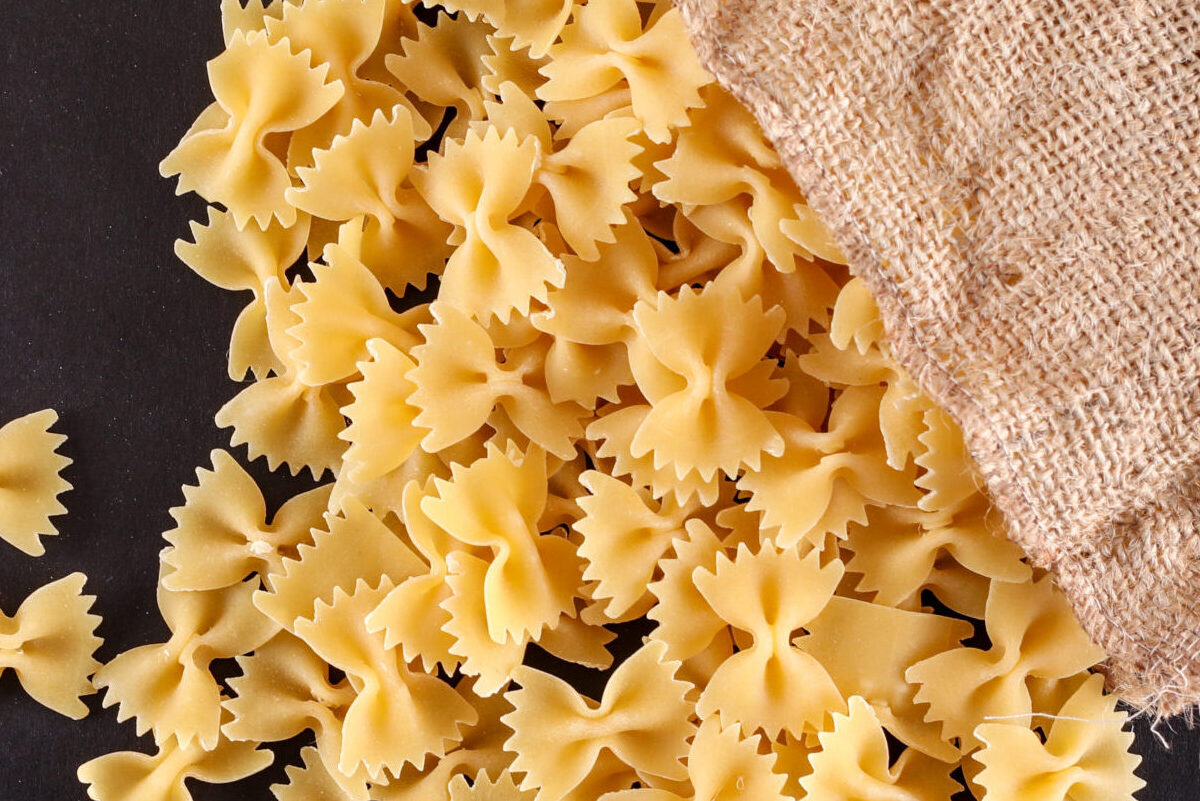Bow tie pasta, or farfalle, is a type of pasta that originated in the Lombardy and Emilia-Romagna regions of Italy. Its distinctive shape, resembling a butterfly or a bow tie, is created by pinching the middle of a square piece of pasta dough. The shape is not only aesthetically pleasing but also functional, as it holds thicker sauces well. However, the same shape can lead to clumping during cooking, especially if not handled correctly. This guide will help you prevent that from happening, so you can Keep Bow Tie Pasta from Sticking Together.
Why Does Bow Tie Pasta Stick Together?
Understanding why pasta sticks together is crucial for preventing it. The main reason pasta sticks is due to the release of starch during cooking. When pasta is added to boiling water, the heat causes the starch molecules on the pasta’s surface to swell and release into the water. If the pasta is too close together, the starch can cause it to bond, resulting in a sticky mess.
Several factors contribute to this issue:
- Overcrowding the Pot: Too much pasta in too little water leads to clumping.
- Inadequate Water: Not using enough water prevents the pasta from moving freely, increasing the chances of sticking.
- Skipping Stirring: If you don’t stir the pasta during the first few minutes, it can settle and stick together.
- Not Draining Properly: Leaving pasta in the cooking water for too long after it’s done can cause it to absorb too much water, leading to stickiness.
Avoiding these common mistakes and following the correct cooking procedures will help ensure that your bow tie pasta doesn’t stick together.
Choosing the Right Pot and Water Ratio for a perfect Bow Tie Pasta.
One of the most crucial steps in cooking pasta is choosing the right pot and ensuring the correct water-to-pasta ratio.
Pot Size Matters
Using a large pot is essential when cooking pasta. The more space the pasta has to move around, the less likely it is to stick together. For every pound of pasta, use at least four to six quarts of water. This ratio helps dilute the starch released and prevents the pasta from clumping.
Water to Pasta Ratio
The correct water-to-pasta ratio is vital. As a general rule, use one gallon of water per pound of pasta. This allows the pasta to move freely and reduces the chances of sticking. The large amount of water also helps wash away excess starch, which is a significant factor in pasta sticking.
For more detailed advice on this, you can check out the guide on bow tie pasta salad recipes, tips, and variations.
Proper Cooking Techniques
Cooking pasta correctly involves more than just boiling water. Here are specific techniques to ensure your farfalle comes out perfectly every time.
Use of Salt in Boiling Water
Adding salt to the boiling water is essential. Salt enhances the flavor of the pasta and helps keep it from sticking by slightly roughening the pasta’s surface. Aim for about one tablespoon of salt per gallon of water.
Tip: Add the salt once the water has reached a boil and just before adding the pasta. This ensures that the salt dissolves completely and distributes evenly.
Stirring During Cooking
Stirring is one of the most effective ways to prevent pasta from sticking. During the first few minutes of cooking, the pasta is most vulnerable because the starches are just beginning to release. Stirring frequently helps separate the pieces and prevents clumping.
Make sure to stir the pasta at regular intervals throughout the cooking process. This will keep the pasta moving and prevent it from settling and sticking together.
The Role of Oil: Myth vs. Reality
Many people add oil to pasta water, believing it will prevent sticking. However, this is largely a myth. While oil does create a slick surface, it can also prevent sauce from adhering to the pasta, which is counterproductive.
Instead of adding oil to the water, focus on proper stirring and using the correct amount of water. If you need to prevent the pasta from sticking after draining, consider lightly tossing it with olive oil or melted butter, especially if you’re not adding the sauce immediately.
For further insights into pasta preparation, consider exploring tips on mastering the art of perfect French toast, which shares similar principles of achieving optimal texture in cooking.
Rinsing Pasta: When and Why?
Rinsing pasta is a debated topic among cooks. While it can help prevent sticking, it also washes away surface starch, which helps sauces cling to the pasta.
Rinsing in Cold Water Post-Boiling
Rinsing pasta in cold water after boiling can be beneficial in specific situations, particularly when preparing pasta for cold dishes like salads or when you’re making a large batch ahead of time. Cold water halts the cooking process and cools the pasta quickly, reducing the likelihood of sticking.
Pros and Cons of Rinsing Pasta
- Pros: Prevents sticking, stops the cooking process, and cools the pasta quickly.
- Cons: Removes surface starch, which helps sauces cling to the pasta, and can cool pasta too much if not used immediately.
For most pasta dishes, particularly those with sauce, it’s better to skip the rinse and rely on proper cooking techniques to prevent sticking.
Post-Cooking Strategies
What you do after cooking pasta is just as important as the cooking process itself. Here are some strategies to keep your bow tie pasta from sticking after it’s been drained.
Using a Sauce to Prevent Sticking
One of the easiest ways to prevent pasta from sticking is to add the sauce immediately after draining. The sauce adds flavor and creates a barrier that prevents the pasta from clumping together. Farfalle works particularly well with thicker sauces that can cling to its ridged surface.
If you’re curious about combining pasta with different flavors, you might find this guide on buffalo chicken salad helpful, as it discusses the interplay of textures and sauces in salads.
Tossing Pasta in Olive Oil or Butter
If you don’t plan to add the sauce right away, consider tossing the pasta in a small amount of olive oil or melted butter. This will coat the pasta and help keep it separated. Be careful not to overdo it, as too much oil can make the pasta greasy and prevent the sauce from sticking later.
Special Tips for Fresh Pasta

Fresh pasta is more delicate than dried pasta and requires special care to prevent sticking.
Difference Between Fresh and Dried Pasta
Fresh pasta contains more moisture than dried pasta, making it more prone to sticking. It also cooks much faster, so it’s essential to pay close attention to the cooking time.
Techniques Specific to Fresh Pasta
- Flouring the Pasta: Lightly dust fresh pasta with flour before cooking to help prevent sticking.
- Quick Cooking: Fresh pasta usually cooks in 2-4 minutes, so keep a close eye on it and stir frequently.
- Rinsing Fresh Pasta: If you’re not serving the pasta immediately, rinse it with cold water and toss it with a little oil to prevent sticking.
Storing Cooked Pasta
If you need to store cooked pasta for later use, proper storage is key to preventing it from sticking together.
Best Practices for Storing Cooked Pasta
- Cool It Quickly: Spread the pasta out on a baking sheet to cool quickly and prevent clumping.
- Use Airtight Containers: Store the pasta in airtight containers to keep it fresh.
- Toss with Oil: Before storing, toss the pasta with a small amount of olive oil to keep it from sticking.
Reheating Tips for Maintaining Texture
When reheating, add a splash of water or broth and stir gently to help separate the pasta and maintain its texture.
For more ideas on how to keep your pasta dishes fresh and exciting, consider this post on bow tie pasta salad recipes, tips, and variations.
FAQs
Here are answers to some frequently asked questions about cooking bow tie pasta and preventing it from sticking:
- How long should you boil bow tie pasta?
- Typically, farfalle should be boiled for 10-12 minutes for an al dente texture. Always check the package instructions, as cooking times can vary.
- Is it better to rinse pasta with hot or cold water?
- Cold water is better for rinsing pasta if you’re using it in a cold dish or storing it. However, avoid rinsing if you’re serving the pasta immediately with a sauce.
- Can you prevent pasta from sticking without oil?
- Yes, by using adequate water, stirring frequently, and adding the sauce immediately after cooking.
- Why do you put salt in pasta water?
- Salt enhances flavor and helps prevent pasta from sticking by raising the boiling point of the water.
- Should pasta be rinsed before cooking?
- No, pasta should not be rinsed before cooking as this removes the surface starch that helps the sauce cling to the pasta.
By following these tips and techniques, you can ensure that your bow tie pasta is always perfectly cooked and free from clumps. Whether you’re making a quick weeknight dinner or preparing a pasta salad for a gathering, keeping your pasta from sticking will make all the difference in the final dish.


2 thoughts on “How Do You Keep Bow Tie Pasta from Sticking Together ?”